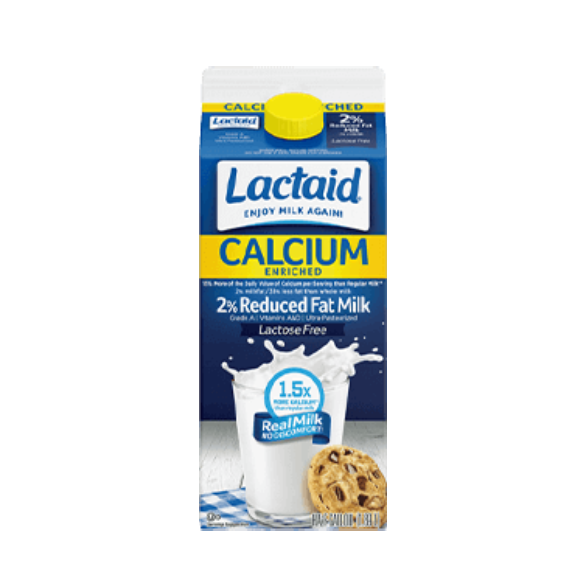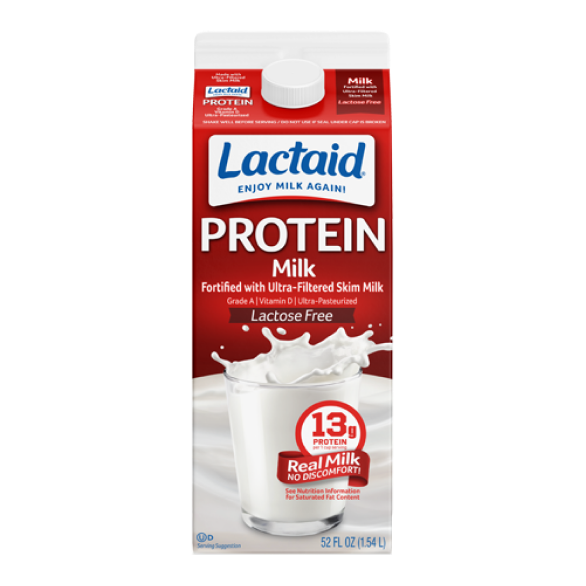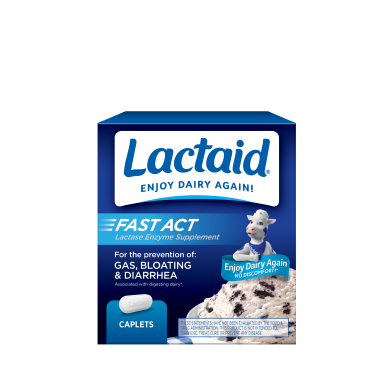Conoces la sensación: tu estómago comienza a quejarse de 30 minutos a un par de horas después de ingerir lácteos. You put up with it because you want to enjoy the taste of real dairy but feel uncomfortable every time you eat your favorite foods. If this sounds familiar, then you may be experiencing symptoms of lactose intolerance1 .
Lactose intolerance, also known as lactose sensitivity, is a very common condition where the gut has problems digesting lactose, a sugar that’s naturally found in milk and other dairy products1 . After eating dairy, symptoms of lactose sensitivity can kick in about 30 minutes to two hours after, depending on how much dairy you ate or how sensitive you are to lactose2 . They can vary from a brief stomach rumble to nausea or even full-on diarrhea3 .
Common Symptoms of Lactose Intolerance
If you’re sensitive to lactose, common symptoms you may experience include:
- Inflamación
- Gases
- Diarrea
- Stomach and abdominal pain
- Nausea and vomiting
How Long Do Lactose Intolerance Symptoms Last?
It’s hard to pinpoint the exact time when lactose sensitivity symptoms start and end. But you’ll most likely experience symptoms around 30 minutes to two hours after eating dairy. Symptoms will often last until all the lactose in your gut passes through the body, which can take up to 48 hours4 .
How Do You Tell if You’re Lactose Intolerant, or It’s Something Else?
Lactose intolerance, milk allergies and IBS all present with similar symptoms, but they are quite different conditions. Here’s everything you need to know:
Lactose Intolerance vs Milk Allergy
To put it plainly, lactose intolerance or sensitivity is a digestive issue caused by the inability to digest lactose (milk’s natural sugar), while a milk allergy is an immune system issue.
When you have a milk or dairy allergy, that means your body’s immune system is reacting to common proteins found in cow’s milk – like a casein allergy or whey allergy. While both disorders may share similar symptoms, a milk protein allergy is usually more serious than lactose sensitivity and must be treated differently5.
Common symptoms of a milk allergy, which do not occur with lactose intolerance or sensitivity, include:
- Wheezing
- Constriction of airways
- A swollen tongue
- Itching
- Shock (with a drop in blood pressure)6
Not sure what could be causing your discomfort? Take our quick quiz to see if your symptoms could mean lactose intolerance or a dairy allergy.
IBS vs Lactose Intolerance
IBS and lactose intolerance are usually confused with each other because symptoms are almost identical. Irritable bowel syndrome, or IBS, is a condition that affects the stomach and gut. While the exact cause of IBS is unknown, it mostly occurs in people who have:
- Anxiety, tension or emotional stress
- A family history of IBS
- An infection of the digestive tract
- Women are also twice as likely to have IBS compared to men7
Because it’s harder to diagnose IBS compared to lactose intolerance, your doctor might test you for lactose intolerance, celiac disease and other gastrointestinal disorders before narrowing it down to IBS.
While IBS symptoms can be strikingly similar to those of lactose intolerance, IBS is a bowel disorder, while lactose intolerance is a condition caused by your body’s inability to digest lactose7 .
Dairy Sensitivity vs Lactose Intolerance
Dairy sensitivity is an umbrella term referring to any symptoms caused by lactose sensitivity or a milk allergy. When someone says that they’re ‘dairy sensitive’, they could be referring to a digestive or allergic issue with milk and dairy products. That’s why it’s so important to know the condition you have first before finding an alternative dairy product.
You might be missing out on the delicious taste of dairy simply because you think you have a milk allergy!
Symptoms like stomach pains and diarrhea are common in both lactose intolerance and milk allergies. However, lactose intolerance should be treated differently from milk allergies5 .
Dairy allergies are pretty widespread in children. In fact, two in every 100 children under the age of four are allergic to milk. It’s also very common in babies8 .
NOTA: If you have a milk allergy or suspect your child has one, consult your physician first before attempting to eat any milk or dairy products.
If you know that you are sensitive to dairy, but you’re unsure if it’s lactose intolerance or a dairy allergy, try taking our quiz to help you determine the cause of your discomfort.
¿Qué debo hacer luego?
Before you stop eating dairy because of a lactose sensitivity, try altering your diet to ease your symptoms. You can also try LACTAID® supplements or our other lactose-free products to see if that helps too. If your symptoms don’t clear up, be sure to mention this to your healthcare professional.
When to See a Doctor
While lactose intolerance is not considered life-threatening, severe lactose intolerance and reactions to milk allergens can be serious. You should seek immediate medical attention if you:
- Get hives
- Develop rashes
- Have trouble swallowing
- Start wheezing
- Experience tightness in the throat
- Start swelling in the lips and face6
FAQ
Your doctor will perform a skin prick test to determine if you have a lactose sensitivity or a milk allergen. In the skin prick test, a small droplet containing a dairy allergen is placed on your skin (on your back or forearm). If a red itchy patch appears, then you most likely have a dairy allergen.
Your doctor might also perform a blood test to measure specific antibodies in your blood.*
If your doctor suspects that you have lactose intolerance, they may also perform a hydrogen breath test. You'll drink a liquid containing a high lactose concentration, and your doctor will then measure the hydrogen in your breath at regular intervals. If there is a high amount of hydrogen in your breath, it means your body isn’t fully capable of absorbing lactose.
Your doctor might also perform a blood test to measure the concentration of glucose in your blood two hours after giving you a drink containing a high level of lactose.** If your glucose levels don’t rise, it means your body isn't properly digesting the lactose-filled drink.
*Reference: Lactose Intolerance vs. Dairy Allergy. WebMD. https://www.webmd.com/digestive-disorders/lactose-intolerance-or-dairy-allergy
**Reference: Lactose Intolerance. Mayo Clinic. https://www.mayoclinic.org/diseases-conditions/lactose-intolerance/diagnosis-treatment/drc-20374238
Sí. Feeling bloated is a symptom of lactose intolerance. It most likely is a result of gas building up in your gut because your body cannot digest the lactose found in milk and dairy.
Sí. You might be suffering from a milk allergy. You should seek medical attention immediately if you start wheezing or have difficulty breathing.*
*Reference: Lactose Intolerance vs. Dairy Allergy. WebMD. https://www.webmd.com/digestive-disorders/lactose-intolerance-or-dairy-allergy
Don’t see your question? Visit our FAQs page.
SEE ALL FAQS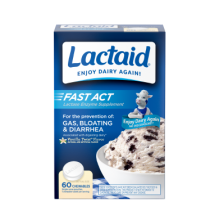
Suplementos de enzima lactasa en tabletas masticables LACTAID® Fast Act
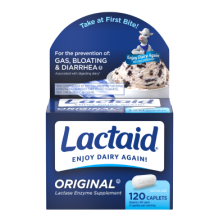
Comprimidos de suplemento de enzima lactasa LACTAID® Original Strength

Helado sin lactosa de vainilla LACTAID®


¿Eres intolerante a la lactosa?
Responde algunas preguntas para ver si tus síntomas pueden ser debido a la intolerancia a la lactosa o a una alergia a la leche.
HAZ EL EXAMEN









